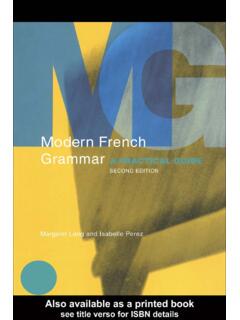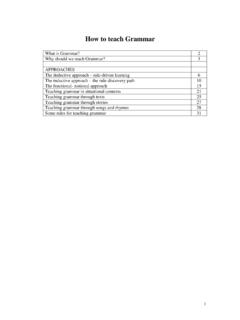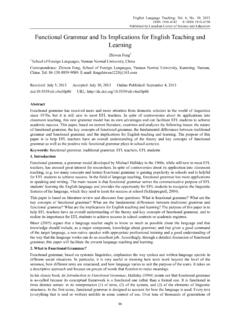Transcription of Chomsky’s Universal Grammar and Halliday’s Systemic ...
1 Pan Pacific Association of Applied Linguistics 12(1), 11 28 11 2008 PAAL 1345 8353/00 Chomsky s Universal Grammar and Halliday s Systemic functional Linguistics: An Appraisal and a Compromise Mohammad Bavali and Firooz Sadighi Azad University, Shiraz Branch Sadighi, F. & Bavali, M. (2008) Chomsky s Universal Grammar and Halliday s Systemic functional Linguistics: An appraisal and a compromise. Journal of Pan-Pacific Association of Applied Linguistics, 12(1), 11-28. Recent developments in theories of language (grammars) seem to share a number of tenets which mark a drastic shift from traditional disentangled descriptions of language: emphasis on a big number of discrete grammatical rules or a corpus of structure patterns has given way to a more unitary, explanatory powerful description of language informed by a sound theory of language acquisition, on the one hand, and verified/refuted by observations on samples of language use, on the other.
2 Two widely welcome of such theories are Chomsky s Universal Grammar and Halliday s Systemic functional Linguistics. These two theories have been initiated and developed almost independently and each has been successful in accounting for aspects of language from a particular perspective. However, they seem to stand more in a complementary position with respect to each other than in a confronting stance against one another. This article aims at providing evidence for such a claim to support the argue that not only aren t these two theories mutually exclusive but they are rather mutually dependent; there is a sense in which each needs to internalize and incorporate aspects of the other if a fully fledged account of language is to be achieved. Key Words: Systemic functional linguistics, Universal Grammar , (in) congruent forms, cliticization 1 Introduction Since its birth in early 20th century, linguistics has witnessed a big number of changes in its trends, orientations, subjects of study, and hence theories of language and language acquisition.
3 Apart from the influential re orientation from the historical or diachronic linguistics towards a synchronic linguistics which marked the beginning of modern linguistics, the most salient demarcation line between current theories of Grammar can be sketched by way of reference to Saussure s consideration of syntagmatic versus paradigmatic relations among linguistic items (Sampson, 1980). Linguistic items are said to be syntagmatically related when viewed as a linear sequence and paradigmatically related when viewed as potential substitutes for their similarly positioned counterparts within the given First/corresponding author: Firooz Sadighi, second author: Mohammad Bavali. Mohammad Bavali and Firooz Sadighi 12 sequence. Grammars, then, could be viewed as seeing the language as knowledge of either primarily syntagmatic relations among linguistic constituents or predominantly paradigmatic relations among linguistic items.
4 The former has led to grammars such as Markov s Finite State Grammar , structural (descriptive) linguistics, and Chomsky s generative transformational Grammar (now UG) ,and the latter has given rise to Firth s London school of linguistics, Jakobson s Prague school of linguistics, and Halliday s Systemic functional linguistics (see Lyons, 1981 and Sampson, 1980). Two theories, of those just mentioned have attracted most attention and have been frequently addressed and employed in literature on both linguistics and applied linguistics. They are Chomsky s Universal Grammar and Halliday s Systemic functional Linguistics. These two theories have been initiated and developed almost independently and each has been successful in accounting for aspects of language from a particular perspective. However, they seem to stand more in a complementary position with respect to each other than in a confronting stance against one another.
5 The following lines bear an account of these two theories of language, their merits and inadequacies, and the way in which each would contribute to the completion of the other. 2 Chomsky s Universal Grammar In Chomskyan tradition, Grammar of a language is an account of the grammatical competence (rather than performance) of the native speakers of that language. Grammatical competence is defined as the native speakers tacit knowledge of the Grammar of their language (Chomsky, 1965). Native speakers grammatical competence is determined by eliciting their intuitions about grammaticality of sentences generated in their own language (known as grammaticality judgments) and about the interpretation of sentences ( realizing ambiguous or paraphrase forms, etc.) (ibid). A Grammar is said to be descriptively adequate if it yields the same statements about the (un)grammaticality and interpretations of the sentences as the native speakers of that language do.
6 A Universal Grammar , however, is not an account of the Grammar of an individual language ( English, or French). It is, more precisely, a theory of Grammar ; it is, in Radford s (1997) words, a set of hypotheses about the nature of possible and impossible grammars of natural ( human) languages ( ). It follows that any Grammar could be descriptively adequate if and only if it describes the properties of the intended language in accordance with and from among those Universal properties already predicted and devised within the theory of Universal Grammar . This gives rise to one further criterion; that of universality. The second criterion of adequacy for grammars is that of explanatory adequacy. A theory of Universal Grammar (henceforth UG) is said to be explanatorily adequate if it could successfully explain why it contains the properties it does. In addition to all these criteria, there are still three more conditions to be satisfied by a theory of UG: one that any theory of UG must be restrictive in nature; that is the descriptive power of the UG must not be so unlimited that its descriptive Chomsky s UG and Halliday s Systemic functional Linguistics 13 devices could describe as well the artificial languages ( computer and mathematics languages) or other human and non human communication systems.
7 One more criterion of adequacy that a theory of language must meet is the learnability principle which assumes that a linguistic theory is adequate if and only if the Grammar it generates could be easily learned by children in a relatively short period of time just as they normally do in early childhood. In other words, the Grammar must be as simple as possible. These have led to a new movement within UG, beginning in 1990s by Chomsky himself, which aims at minimizing the theoretical and descriptive devices in devising grammatical properties of natural languages in favor of maximizing the simplicity and hence learnability of the Grammar . This movement is known as Minimalism. Closely associated with a theory of UG is the problem of explicating the acquisition of Grammar known as the Logical Problem (Hawkins, 2001, ; Foster Cohen, 1999, ). It addresses the important question of how children acquire the Grammar of their language (the initial stage) so rapidly and uniformly in a remarkably short period of time (at around the age of 18 months up to around 30 months).
8 A second problem, known as the developmental problem, concerns the way(s) in which children go through other stages (transition and final stage) of learning (ibid). Chomsky s explanation for such phenomena is that children are genetically predisposed with an innate language faculty which facilitates the acquisition of language. This innate language faculty is what Chomsky conceives of as UG which comprises a set of implicit abstract principles that govern the grammatical operations allowed and not allowed in all natural languages. Examples of such principles are structure dependence principle (which holds that all grammatical operations are structure dependent, they are, according to Radford (ibid, ), sensitive to the grammatical structure of the sentences they apply to). To account for the observed differences across languages in their grammatical structure, UG has incorporated into its structure a number of language specific variations which children have to learn as part of the task of acquiring their native language.
9 Thus, language acquisition involves not only lexical learning but also some structural learning (ibid, ). These grammatical variations are referred to as parameters. It follows that while some aspects of the grammatical structure of languages are determined by innate grammatical principles which will not have to be learned by children, some others have to be acquired as parametric variations across languages. In other words, structural learning will be limited to parameterized aspects of structure (p. 16). Examples of parameters include null subject parameter according to which some languages (Italian, Spanish, Irish, Chinese, etc.) are null subject, their finite verbs license either overt or covert (null) subjects, while others are non null subject languages (French, English, etc.), that is finite verbs in such languages license only overt subjects, not null subjects. One important point to consider is that there are genetic constraints on the range of structural (parametric) variation allowed in different languages so that, in principle, all parametric variations appear to oscillate along a binary choice (with only two possible settings) and that any language allows for only one (uniform) possibility Mohammad Bavali and Firooz Sadighi 14 and not a combination of both (no single language with some forms set to one value and others set to the other).
10 Word order is an important aspect of grammatical structure which is parameterized along various constructions. One such constructions makes up the wh-parameter which determines whether wh expressions can be fronted or not. Another type of word order variation is called the head position parameter which states that languages vary in terms of the relative position of heads with respect to their complements within phrases: while English is a head first language, Japanese is a head last language. In light of the above, one can generalize that the only structural learning which children face in acquiring their native language is the task of determining the appropriate value for each of the relevant structural parameters along which languages vary (p. 20). 3 Halliday s Systemic functional Linguistics Systemic functional Grammar or Linguistics, first introduced by Michael Halliday (1985), refers to a new approach to the study of Grammar that is radically different from the traditional view in which language is a set of rules for specifying grammatical structures.

















